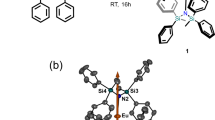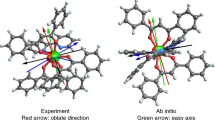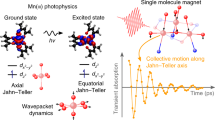Abstract
Single-molecule magnets are compounds that exhibit magnetic bistability caused by an energy barrier for the reversal of magnetization (relaxation). Lanthanide compounds are proving promising as single-molecule magnets: recent studies show that terbium phthalocyanine complexes possess large energy barriers, and dysprosium and terbium complexes bridged by an N23− radical ligand exhibit magnetic hysteresis up to 13 K. Magnetic relaxation is typically controlled by single-ion factors rather than magnetic exchange (whether one or more 4f ions are present) and proceeds through thermal relaxation of the lowest excited states. Here we report polylanthanide alkoxide cage complexes, and their doped diamagnetic yttrium analogues, in which competing relaxation pathways are observed and relaxation through the first excited state can be quenched. This leads to energy barriers for relaxation of magnetization that exceed 800 K. We investigated the factors at the lanthanide sites that govern this behaviour.
This is a preview of subscription content, access via your institution
Access options
Subscribe to this journal
Receive 12 print issues and online access
$259.00 per year
only $21.58 per issue
Buy this article
- Purchase on Springer Link
- Instant access to full article PDF
Prices may be subject to local taxes which are calculated during checkout

Similar content being viewed by others
References
Ishikawa, N., Sugita, M., Ishikawa, T., Koshihara, S-Y. & Kaizu, Y. Lanthanide double-decker complexes functioning as magnets at the single-molecular level. J. Am. Chem. Soc. 125, 8694–8695 (2003).
Takamatsu, S., Ishikawa, T., Koshihara, S-Y. & Ishikawa, N. Significant increase of the barrier energy for magnetization reversal of a single-4f-ionic single-molecule magnet by a longitudinal contraction of the coordination space. Inorg. Chem. 46, 7250–7252 (2007).
AlDamen, M. A. et al. Mononuclear lanthanide single molecule magnets based on the polyoxometalates [Ln(W5O18)2]9− and [Ln(β2-SiW11O39)2]13− (LnIII = Tb, Dy, Ho, Er, Tm, and Yb). Inorg. Chem. 48, 3467–3479 (2009).
Habib, F. et al. Supramolecular architectures for controlling slow magnetic relaxation in field-induced single-molecule magnets. Chem. Sci. 3, 2158–2164 (2012).
Woodruff, D. N., Winpenny, R. E. P. & Layfield, R. A. Lanthanide single-molecule magnets. Chem. Rev. http://dx.doi.org/10.1021/cr400018q (2013).
Jiang, S-D. et al. Series of lanthanide organometallic single-ion magnets. Inorg. Chem. 51, 3079–3087 (2012).
Sorace, L., Benelli, C. & Gatteschi, D. Lanthanides in molecular magnetism: old tools in a new field. Chem. Soc. Rev. 40, 3092–3104 (2011).
Baldoví, J. J., Borrás-Almenar, J. J., Clemente-Juan, J. M., Coronado, E. & Gaito-Ariño, A. Modelling the properties of lanthanoid single-ion magnets using an effective point-charge approach. Dalton Trans. 41, 13705–13710 (2012).
Tang, J. K. et al. Dysprosium triangles showing single-molecule magnet behavior of thermally excited spin states. Angew. Chem. Int. Ed. 45, 1729–1733 (2006).
Chibotaru, L. F., Ungur, L. & Soncini, A. The origin of nonmagnetic Kramers doublets in the ground state of dysprosium triangles: evidence for a toroidal magnetic moment. Angew. Chem. Int. Ed. 47, 4126–4129 (2008).
Rinehart, J. D., Fang, M., Evans, W. J. & Long, J. R. Strong magnetic exchange and magnetic blocking in N23− radical-bridged lanthanide complexes. Nature Chem. 3, 538–542 (2011).
Rinehart, J. D., Fang, M., Evans, W. J. & Long, J. R. A N23− radical-bridged terbium complex exhibiting magnetic hysteresis at 14 K. J. Am. Chem. Soc. 133, 14236–14239 (2011).
Layfield, R. A., McDouall, J. J. W., Sulway, S. A., Tuna, F. & Winpenny, R. E. P. Influence of the N-bridging ligand in dimetallic organometallic dysprosium single molecule magnets. Chem. Eur. J. 16, 4442–4446 (2010).
Katoh, K., Isshiki, H., Komeda, T. & Yamashita, M. Molecular spintronics based on single-molecule magnets composed of multiple-decker phthalocyaninato terbium(III) complex. Chem. Asian J. 7, 1154–1169 (2012).
Urdampilleta, M., Cleuziou, J-P., Klyatskaya, S., Ruben, M. & Wernsdorfer, W. Supramolecular spin valves. Nature Mater. 10, 502–506 (2011).
Vincent, R., Klyatskaya, S., Ruben, M, Wernsdorfer, W. & Balestro, F. Electronic read-out of a single nuclear spin using a molecular spin transistor. Nature 488, 357–360 (2012).
Petit, S., Pilet, G., Luneau, D., Chibotaru, L. F. & Ungur, L. A dinuclear cobalt(II) complex of calix[8]arenes exhibiting strong magnetic anisotropy. Dalton Trans. 40, 4582–4588 (2007).
Chibotaru, L. F. et al. Structure, magnetism and theoretical study of a mixed-valent CoII3CoIII4 heptanuclear wheel: lack of SMM behaviour despite negative magnetic anisotropy. J. Am. Chem. Soc. 130, 12445–12455 (2008).
Ungur, L. & Chibotaru, L. F. Magnetic anisotropy in the excited states of low symmetry lanthanide complexes. Phys. Chem. Chem. Phys. 13, 20086–20090 (2011).
Mondal, K-C. et al. Evidence for coexistence of distinct single-ion and exchange-based mechanisms for blocking of magnetization in a CoII2DyIII2 single molecule magnet. Angew. Chem. Int. Ed. 51, 7550–7554 (2012).
Cucinotta, G. et al. Magnetic anisotropy in a dysprosium/DOTA single-molecule magnet: beyond simple magneto-structural correlations. Angew. Chem. Int. Ed. 51, 1606–1610 (2012).
Finn, C. B. P., Orbach, R. & Wolf, W. P. Spin-lattice relaxation in cerium magnesium nitrate at liquid helium temperature: a new process. Proc. Phys. Soc. 77, 261–268 (1961).
Blagg, R. J., Muryn, C. A., McInnes, E. J. L., Tuna, F. & Winpenny, R. E. P. Single pyramid magnets: Dy5 pyramids with slow magnetic relaxation to 40 K. Angew. Chem. Int. Ed. 50, 6530–6532 (2011).
Luis, F. et al. Spin-lattice relaxation via quantum tunnelling in an Er3+ polyoxometallate single molecule magnet. Phys. Rev. B 82, 060403 (2010).
Meihaus, K. R., Rinehart, J. D. & Long, J. R. Dilution-induced slow magnetic relaxation and anomalous hysteresis in trigonal prismatic dysprosium(III) and uranium(III) complexes. Inorg. Chem. 50, 8484–8489 (2011).
Luzon, J. et al. Spin chirality in a molecular dysprosium triangle: the archetype of the noncollinear Ising model. Phys. Rev. Lett. 100, 247205 (2008).
Cardona-Serra, S. et al. Lanthanoid single-ion magnets based on polyoxometallates with a 5-fold symmetry. The series [LnP5W30O110]12− (Ln3+ = Tb, Dy, Ho, Er, Tm and Yb). J. Am. Chem. Soc. 134, 14982–14990 (2012).
Long, J. et al. Single-molecule magnet behaviour for an anti-ferromagnetically superexchange-coupled dinuclear dysprosium(III) complex. J. Am. Chem. Soc. 133, 5319–5328 (2011).
Guo, Y-N. et al. Strong axiality and Ising exchange interaction suppresses zero-field tunneling of magnetization of an asymmetric Dy2 single-molecule magnet. J. Am. Chem. Soc. 133, 11948–11951 (2011).
Sulway, S. A., Layfield, R. A., Tuna, F., Wernsdorfer, W. & Winpenny, R. E. P. Single-molecule magnetism in cyclopentadienyl-dysprosium chlorides. Chem. Commun. 48, 1508–1510 (2012).
Van den Broek J. & Van der Marel, L. C. Spin-lattice relaxation in rare earth ethylsulphates II. Physica 30, 565–587 (1964).
Garanin, D. A. & Chudnovsky, E. M. Thermally activated resonant magnetization tunnelling in molecular magnets: Mn12Ac and others. Phys. Rev. B 56, 11102–11118 (1997).
Blagg, R. J., Tuna, F., McInnes, E. J. L. & Winpenny, R. E. P. Pentametallic lanthanide-alkoxide square-based pyramids: high energy barrier for thermal relaxation in a holmium single molecule magnet. Chem. Commun. 47, 10587–10589 (2011).
Ganivet, C. R. et al. Influence of peripheral substitution on the magnetic behaviour of single-ion magnets based on homo- and heteroleptic TbIII bis(phthalocyaninate). Chem. Eur. J. 19, 1457–1465 (2013).
Acknowledgements
This work was supported by the Engineering and Physical Sciences Research Council (UK), by the Flemish Science Foundation (fellowship to L.U.) and by the European Research Council Advanced Grant MolNanoSpin (number 226558) and ICT-2007.8.0 Future Emerging Technologies Open, Quantum Information Processing Specific Targeted Research Project number 211284 MolSpinQIP. R.E.P.W. thanks The Royal Society for a Wolfson research merit award, and financial support from the Institute for Nanoscale Physics and Chemistry and Methusalem programs at KU Leuven is gratefully acknowledged. We also acknowledge Diamond Light Source for access to synchrotron X-radiation.
Author information
Authors and Affiliations
Contributions
E.J.L.M., D.C. and R.E.P.W. designed the research. R.J.B., P.C. and J.S. made the compounds; R.J.B. also carried out the X-ray studies. L.U. and L.F.C. performed the ab initio calculations and proposed the interpretation. F.T. and W.W. performed the magnetic measurements. E.J.L.M., D.C. and R.E.P.W. co-wrote the paper with input from all other authors.
Corresponding authors
Ethics declarations
Competing interests
The authors declare no competing financial interests.
Supplementary information
Supplementary information
Supplementary information (PDF 3719 kb)
Supplementary information
Crystallographic data for compound 1.C6H14, [Gd4K2O(OtBu)12].C6H14 (CIF 106 kb)
Supplementary information
Crystallographic data for compound 2.C6H14, [Tb4K2O(OtBu)12].C6H14 (CIF 106 kb)
Supplementary information
Crystallographic data for compound 3.C6H14, [Dy4K2O(OtBu)12].C6H14 (CIF 113 kb)
Supplementary information
Crystallographic data for compound 4.C6H14, [Ho4K2O(OtBu)12].C6H14 (CIF 106 kb)
Supplementary information
Crystallographic data for compound 5.C6H14, [Er4K2O(OtBu)12].C6H14 (CIF 110 kb)
Supplementary information
Crystallographic data for compound 7.C6H14, [Y4K2O(OtBu)12].C6H14 (CIF 107 kb)
Rights and permissions
About this article
Cite this article
Blagg, R., Ungur, L., Tuna, F. et al. Magnetic relaxation pathways in lanthanide single-molecule magnets. Nature Chem 5, 673–678 (2013). https://doi.org/10.1038/nchem.1707
Received:
Accepted:
Published:
Issue Date:
DOI: https://doi.org/10.1038/nchem.1707
This article is cited by
-
Vibrational properties of a mononuclear dysprosium containing singlemolecule magnet
Interactions (2024)
-
Magnetic relaxation in epitaxial films with in-plane and out-of-plane anisotropies
Applied Physics A (2023)
-
Achieving large thermal hysteresis in an anthracene-based manganese(II) complex via photo-induced electron transfer
Nature Communications (2022)
-
Electron transfer photochromism of Ln-based (Ln = Dy, Tb) coordinated polymers for reversibly switching off/on single-molecule magnetic behavior
Science China Materials (2022)
-
Incorporation of expanded organic cations in dysprosium(III) borohydrides for achieving luminescent molecular nanomagnets
Scientific Reports (2021)






